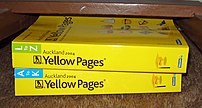 Image via Wikipedia
Image via Wikipedia Unprinted newsprint is (or was – keep reading) widely used for industrial void fill, surface protection, and wrapping applications. You’ve probably seen it at one time or another when you moved. Moving companies use newsprint extensively, mainly in sheeted form, to protect your belongings before boxing them up.
Did you ever wonder where this newsprint comes from?
A Good Green Story …
For the most part, industrial newsprint is trim and waste generated by paper mills as they run newspaper-grade newsprint. I was in Montreal once getting a tour of an Abitibi newsprint mill, and the tour guide took us to a building that must have been 750,000 square feet. He opened an immense sliding door and we saw that the building was packed floor to ceiling with trim newsprint rolls — big, heavy rolls, 40″ – 50″ diameter, anywhere from 12″ – 84″ wide.
Newsprint mills sell this paper at scrap prices to converters that sheet it down for moving companies and other types of users. Some of the scrap newsprint is colored — pink, yellow, blue. That’s because when the paper mill switches from running, say, white pages to yellow pages for the phone book, it generates transitional material with too much color variation for printing.
Newsprint and many other industrial papers, such as bogus kraft, come to market this way. Industrial users who make use of this material for packaging contribute to sustainability by minimizing paper production waste on a high order of magnitude.
Is Coming to An End
The future of industrial newsprint is bleak, given the decline of printed telephone books and newspapers. Mills have begun repulping their scrap tonnage rather than send it into the secondary market. Fortunately, other types of recycled and recyclable papers are available to fill the void, literally and figuratively.


